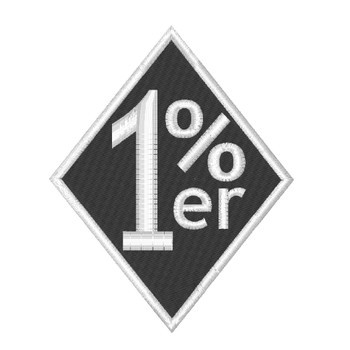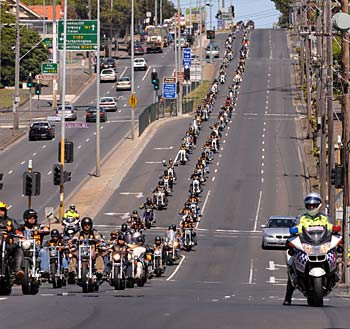The term “one percenter biker,” or “1%er,” immediately conjures images of outlaw motorcycle clubs, groups often shrouded in mystery and misconception. Clubs like the Hells Angels, Bandidos, Pagans, and Outlaws are frequently labeled as “1% motorcycle clubs.” This designation sets them apart, implying they exist outside the norms of mainstream motorcycle culture, suggesting a stark contrast to the “99%” of motorcycle riders perceived as law-abiding citizens. But where did this term originate, and what does it truly mean to be a Biker One Percenter?
 one percenter patchA close-up of a “1%” patch, a symbol worn by biker one percenters to signify their outlaw status within motorcycle culture.
one percenter patchA close-up of a “1%” patch, a symbol worn by biker one percenters to signify their outlaw status within motorcycle culture.
The Genesis of the One Percenter Biker Terminology
The expression “1%,” “1%er,” or “one percenter” entered motorcycle lexicon following the infamous 1947 Hollister Riot in Hollister, California. Amidst the media frenzy surrounding this event, the American Motorcycle Association (AMA), aiming to distance mainstream motorcycle riding from the chaos, purportedly declared that 99% of motorcyclists were law-abiding citizens. In a rebellious counter-statement, certain motorcycle clubs of that era embraced the remaining fraction, proudly proclaiming themselves to be the “one percent.” This bold declaration became a badge of honor, signifying a departure from societal norms and an embrace of a more unconventional lifestyle.
The Rise of Outlaw Motorcycle Clubs and the Biker One Percenter Ethos
The post-World War II era witnessed a significant surge in the outlaw motorcycle club movement, and this timing was far from coincidental. The conclusion of World War II brought home a wave of veterans, many of whom struggled to reintegrate into civilian life. Accustomed to the adrenaline and camaraderie of wartime, some found the normalcy of post-war society lacking in excitement and purpose.
Simultaneously, the market was flooded with surplus Harley Davidson motorcycles, formerly military vehicles now readily available. This confluence of factors – a yearning for excitement and brotherhood among veterans and the availability of robust motorcycles – provided fertile ground for the growth of outlaw motorcycle clubs. These clubs offered a substitute for the intense bonds and exhilarating experiences of war, allowing ex-servicemen to recapture a sense of thrill and belonging within a brotherhood forged on the open road. The biker one percenter identity became deeply intertwined with this spirit of rebellion and camaraderie.
 multiple one percenter clubs meetingA gathering of various biker one percenter clubs, showcasing the network and reach of these organizations within the outlaw motorcycle community.
multiple one percenter clubs meetingA gathering of various biker one percenter clubs, showcasing the network and reach of these organizations within the outlaw motorcycle community.
Prominent Examples of Biker One Percenter Clubs
Biker one percenter clubs have expanded their reach globally, establishing a presence in numerous countries. Clubs such as the Hells Angels Motorcycle Club and the Outlaws Motorcycle Club, among others, operate through localized units known as “chapters” or “charters,” extending their influence across diverse geographical locations. Despite their “outlaw” label, these motorcycle clubs often function as legal entities, and many offer supporter merchandise for sale to the public.
Some of the most recognized biker one percenter clubs worldwide include:
- Hells Angels Motorcycle Club
- Outlaws Motorcycle Club
- Bandidos Motorcycle Club
- Pagans Motorcycle Club
- Mongols Motorcycle Club (though not mentioned in the original article, it’s a significant 1% club)
- Vagos Motorcycle Club (also a key 1% club not in the original text)
The Significance of the 1% Patch for Biker One Percenters
For clubs identifying as biker one percenters, the “1%” patch serves as a visible symbol of their self-proclaimed status. Worn prominently on their vests or jackets, this patch immediately communicates their affiliation with the outlaw motorcycle culture and their separation from mainstream motorcycle riders. It’s a clear and concise declaration of their identity within the biker world.
Media Portrayal and Public Perception of Biker One Percenters
Media coverage of biker one percenter clubs frequently focuses on criminal activities, often highlighting instances of violence. While it is undeniable that some members of these clubs have been involved in criminal behavior, the extent of media attention can be disproportionate, potentially exaggerating the level of public threat posed by these groups. This skewed portrayal can fuel public fear and misrepresent the broader reality of biker one percenter culture.
While there have been cases where innocent individuals have been caught in the crossfire, a significant portion of reported violence associated with outlaw motorcycle clubs occurs amongst rival clubs. The common adage, “live and let live,” often reflects a practical approach to interacting with these groups for those outside of their immediate circles.
 one percenter bikers and policeA tense standoff between biker one percenters and law enforcement, reflecting the often adversarial relationship between outlaw motorcycle clubs and authorities.
one percenter bikers and policeA tense standoff between biker one percenters and law enforcement, reflecting the often adversarial relationship between outlaw motorcycle clubs and authorities.
Governmental Scrutiny and the Biker One Percenter
Government agencies, particularly in the United States, have taken a strong stance against major biker one percenter clubs. The US government has utilized the RICO (Racketeer Influenced and Corrupt Organizations Act) statute, originally designed to combat the Mafia, to target the “Big Four” biker clubs: Hells Angels, Bandidos, Outlaws, and Pagans. This legal strategy underscores the government’s perception of these clubs as organized entities involved in criminal activities.
Beyond the United States, other countries are also adopting measures to counter outlaw motorcycle clubs. Some governments are exploring legislation to restrict interactions among club members, mirroring strategies previously employed against organized crime syndicates.
Understanding the biker one percenter phenomenon requires looking beyond sensationalized media portrayals and recognizing the historical, social, and cultural factors that have shaped this subculture. From its roots in post-war camaraderie and rebellion against societal norms to its current status as a globally recognized, albeit controversial, element of motorcycle culture, the biker one percenter continues to intrigue and provoke discussion.
